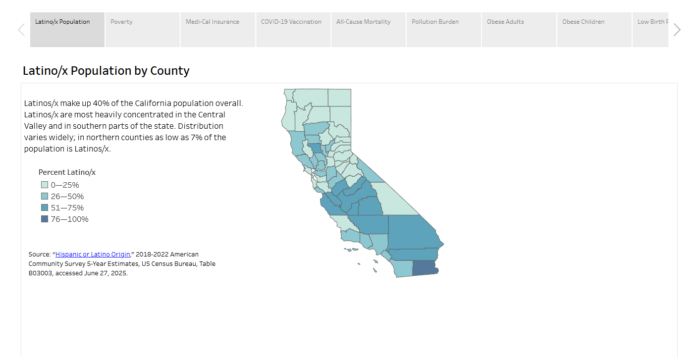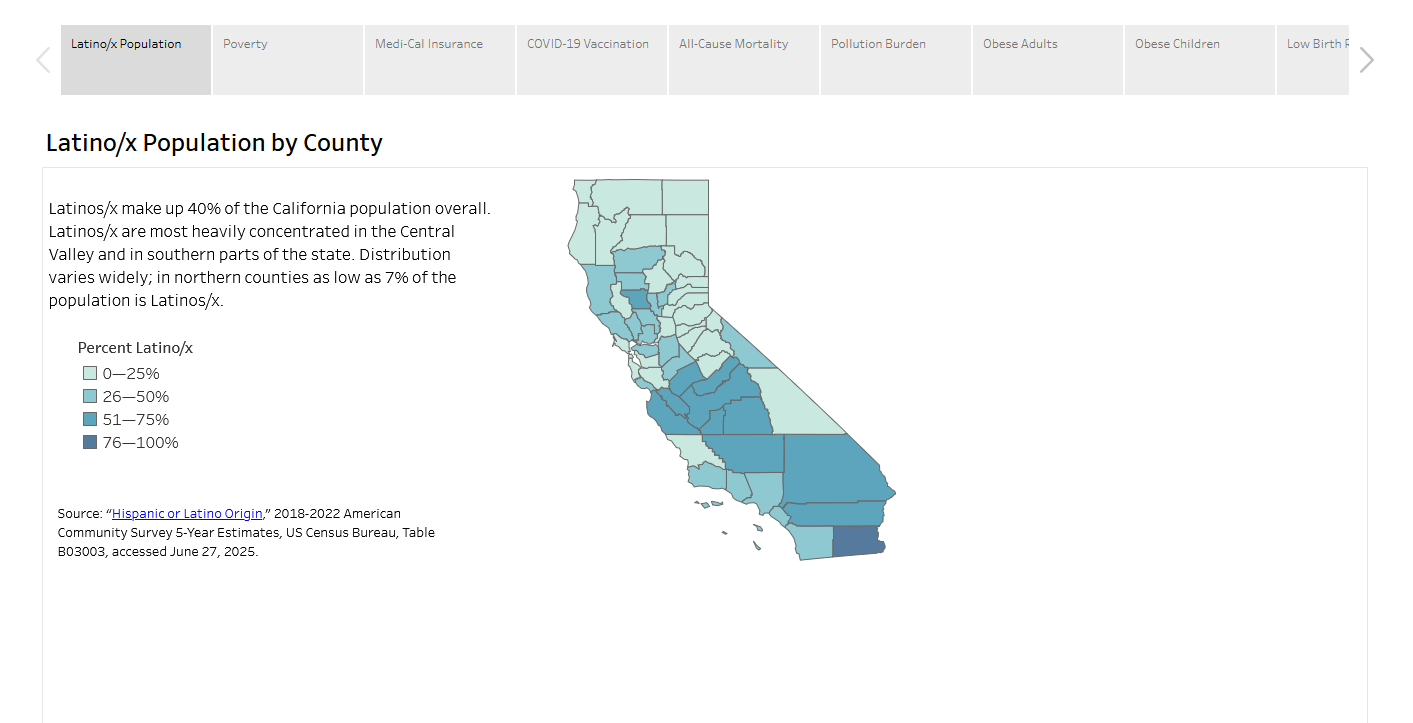Download the Almanac
Almanac
California’s future depends on the health of its largest demographic — Latino/x communities — who, despite their essential role in the state’s economy and culture, continue to face systemic barriers to health and well-being. This Almanac, accompanied by an online dashboard and policy recommendations, serves as a vital resource for highlighting key opportunities to improve health outcomes and promote a healthier California.
KEY FINDINGS INCLUDE:
- Latinos/x comprised 40% of California’s population; two-thirds were US-born.
- The Latino/x population was younger and had lower educational attainment than other groups.
- Latino/x Californians were more likely to receive care in community or government clinics and less likely to have a usual source of care.
- Latino/x children and youth faced higher rates of housing instability, food insecurity, adverse childhood events, and had lower levels of school readiness.
- The ratio of Latino/x physicians, especially specialists, to the population was much lower in comparison to non-Latino/x physicians. Latinos/x are also underrepresented among behavioral health providers, especially psychologists.
- Historically lower mortality rates among Latino/x Californians were temporarily erased during the COVID-19 pandemic in 2020.
- There continues to be a steady rise in obesity, diabetes complications, and diabetes mortality among Latinos/x.
- HIV cases were rising among Latino/x people while dropping for other Californians.
- Adolescent birth rates fell for all groups, but Latina/x adolescents still have rates three times higher than others.
- Pregnant Latinas/x were more likely to be overweight, obese, or have diabetes at delivery and stop breastfeeding earlier than other groups.
- Latino/x children and youth faced higher rates of obesity and dental cavities, exacerbated by high soda consumption.
The complete report and all the charts in the report are available for download below. These materials are part of CHCF’s California Health Care Almanac, an online clearinghouse for key data and analyses describing the state’s health care landscape.
Interactive Dashboard
View additional regional and county-level data on the interactive dashboard.
Policy Recommendations
Latinos/x are a highly diverse population that constitutes the largest racial/ethnic group in California. Understanding and improving their health and well-being is critical to ensuring the prosperity of the state. The California Latino Health Almanac presents data from a wide variety of sources regarding the demographic characteristics of Latino/x Californians; their access to services that improve health; and their physical, behavioral, and oral health status. Analyses of these data reveal multiple opportunities to advance the health of Latino/x Californians.
Purpose and Audience
The information presented in the Latino/x Almanac points to many opportunities to improve access to care and health outcomes for Latino/x Californians. The following recommendations were developed to help decisionmakers identify top priorities and evidence-based strategies for improving Latino/x health. The recommendations are directed toward state and local policymakers, government agencies, health care payers and providers, colleges and universities that educate health professionals, and organizations that advocate on behalf of Californians.
Process Overview
The project team developed the recommendations in collaboration with members of the project’s Community Advisory and Research Advisory groups. The advisory groups were composed of researchers with expertise in Latino/x health, leaders of organizations that address the health needs of Latino/x Californians, and CHCF staff. An initial draft of the recommendations was presented to members of the two advisory groups at a joint meeting held in January 2025. The advisors reviewed and prioritized the recommendations and then discussed in greater detail those that they identified as the highest priorities. Following the meeting, the project team synthesized the advisors’ feedback and produced the final recommendations.
Read these recommendations in the drop-downs below or download the full PDF.
Access to High-Quality Health Care
- Keep Medi-Cal coverage for all Latino/x Californians. Preserve expansion of Medi-Cal coverage for all Latino/x Californians to ensure access to health care, particularly for those who are undocumented. Additionally, the California Department of Health Care Services (DHCS) and counties should continue to prioritize simplifying Medi-Cal renewal procedures and offering support, especially to those who do not speak English, to reduce wrongful disenrollment among the Latino/x population.
- Help more Latino/x students become health professionals. Expand initiatives within private and public education systems that increase the number of Latinos/x entering health professions, such as robust pre-health advising, pathway programs, scholarships, and post-baccalaureate programs. Ensure learners have exposure to underserved. populations during their education and training by increasing the number of safety-net settings that offer rotations, clinical placements, residency positions, and fellowships. Continue to develop infrastructure to train Latino/x health professionals in the Central Valley and other regions with small numbers of Latino/x health professionals and a high proportion of Latino/x patients.
- Increase the availability of health care professionals that speak the patient’s language. Improve access to linguistically concordant clinicians by: (a) funding the training of health professionals in medical Spanish, (b) encouraging California medical schools to take Spanish language skills into account when making admission decisions, and (c) funding initiatives and programs to facilitate speakers of Mesoamerican Indigenous languages entering the health workforce. These efforts should prioritize areas of the state with high concentrations of speakers of Spanish and Mesoamerican Indigenous languages.
- Ensure meaningful language access through oversight, planning, and innovation. To ensure access to interpreters and translated materials for patients who prefer to receive care in a language other than English, health systems should: (a) enhance monitoring and compliance with existing language access laws, (b) develop and implement language access plans, and (c) research and pilot artificial intelligence tools with the community to increase access while ensuring safety and appropriateness and avoiding bias.
- Improve Latino/x access to primary care through outreach and community-based care. To improve Latino/x access to primary care, health systems should: (a) engage community health workers, promotores, and health navigators; (b) enhance access to clear, accessible health care information and use culturally tailored outreach, including traditional and digital media, to help patients navigate the system; and (c) expand access to mobile clinics, telehealth, and community health workers to address barriers like transportation, cost burdens, and fears related to immigration status.
- Track and improve health care quality for Latino/x patients. Health care organizations should continuously collect and examine health care quality metrics for Latinos/x and by preferred language to improve service delivery and quality of care for Latinos/x and those that prefer to receive their health care in a language other than English.
Care for Important Health Conditions
- Implement solutions to reduce obesity for children, youth, and adults. State and local government with partners might consider implementing a multi-pronged strategy to reduce obesity among children, youth, and adults by: (a) supporting affordable and accessible physical activity and nutrition education programs; (b) increasing access to fresh fruits and vegetables through food pantries, produce prescriptions, and voucher programs; (c) taxing sugar sweetened beverages to fund local public health programs; and (d) improving access to anti-obesity medications.
- Increase access to diabetes prevention programs. Payers, health systems, and state and local government could increase access to diabetes prevention programs and support enrollment by supporting navigators, promotores, and community health workers.
- Provide better care for alcohol and substance use disorders. State and local government should consider funding and implementing evidence-based programs to provide linguistically and culturally responsive treatment for alcohol use disorder and other substance use disorders.
- Improve dental care for Latino/x children. Payers and health systems should improve access to and use of dental care for Latino/x children, particularly those insured through Medi-Cal, by expanding available services and using linguistically and culturally tailored outreach strategies, school-based screenings and preventative services, teledental services, promotores, and parental education.
- Support HIV prevention programs for Latino/x communities. State and local health departments should consider funding linguistically and culturally responsive HIV prevention programs for Latinos/x, the largest population group in which HIV prevalence is rising.
Social Factors That Affect Health
- Help Latino/x families get nutrition assistance. State and local agencies, health care organizations, and community-based organizations should facilitate enrollment of eligible Latino/x households with children in government nutrition assistance programs to reduce food insecurity and increase access to nutritious foods. Strategies include clinic site enrollment, virtual engagement, referrals, and flexible appointment scheduling. For ineligible families, resources and support should be provided to increase access to nutritious foods in schools, faith-based institutions, and other community sites (e.g., school meal program, food pantries).
- Support early learning for Latino/x children. State and local government could increase the number of Latino/x students who are ready for kindergarten by expanding access to and enrollment in high-quality care and early learning programs for Latino/x children age zero to three and creating and facilitating enrollment in high-quality preschool programs for Latino/x children age three to five.
- Support environmental and occupational health. State government might consider regulating working conditions in the agricultural sector to reduce exposure to heat, pollutants, and injuries among farmworker communities. Within the San Joaquin Valley, implement and enforce regulations to decrease airborne pollutant exposures among Latino/x families.
Data Collection and Analysis
- Collect more detailed data about Latino/x communities. State and local government as well as health care providers could increase the collection and analysis of demographic and health information about Latino/x-subgroups, including language preferences, to illuminate the diversity of the Latino/x community’s health needs.
Authors & Contributors
Alicia Fernandez, MD
Professor of medicine and director, Latinx Center of Excellence at UCSF
Janet Coffman, PhD, MPP, MA
Professor of health policy and co-associate director; Philip R. Lee Institute for Health Policy Studies, UCSF, Healthforce Center
Lupita Ambriz, MPH
Project director, Latinx Center of Excellence at UCSF
Kyoko Peterson, MPH
Research analyst, Philip R. Lee Institute for Health Policy Studies and Healthforce Center at UCSF
Mario Gonzalez Ramirez
Research analyst, Latinx Center of Excellence at UCSF
Lisel Blash, MPA
Senior research analyst, Philip R. Lee Institute for Health Policy Studies and Healthforce Center at UCSF






